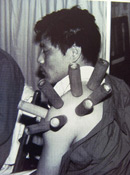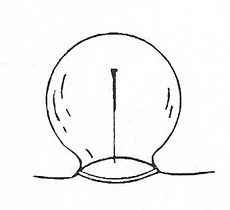Cupping Therapy for Headaches
Cupping was called "horn method" in ancient times. The therapy consists of creating a vacuum by burning a taper inside a cupping jar and quickly placing it over the selected area, which aims to induce local congestion and blood stasis for healing. TCM believes the resulting suction effect helps draw out pathogens, promote the flow of blood and qi, unblock the meridians, and release swelling and pain.
 |
| Traditional bamboo
cupping treatment |
In its early applications, animal horns and bamboo jars were used, which was mainly for draining running sores. Nowadays, cupping is widely applied in muscle strain injuries, and also in the treatment of gastroenteritis, hypertension, headaches, common cold, coughs, menstrual cramps, skin problems, poisonous insect and snake bites. There are different ways to apply cupping, and it often uses alongside others methods like acupuncture and moxibustion, so as to treat complicated conditions. After treatment, there are some marks or bruises left, which are normal and will disappear in a few days. Cupping therapy is NOT suitable for individuals with high fever, generalized spasms, skin allergic or ulcers and those who bleed easily.
Below are the cupping therapies for headaches.
Applications based on the disharmony patterns of headaches
| 1. |
Headaches due to wind-cold: feng men (Bl 12), tai yang (Ex-Hn 5), xin she (extraordinary acupoint, at the side of the fourth cervical vertebra), and wai guan (Sj 5); |
| 2. |
Headaches due o wind-heat: feng men, tai yang, qu chi (Li 11), and da zhui (Gv 14); |
| 3. |
Headaches due to liver yang: feng men, tai yang, yin tang (Ex-Hn 3), tai chong (Lr 3, needling or pressing only); |
| 4. |
Headaches due to turbid phlegm: feng men, tai yang, zhong wan (Cv 12) and feng long (St 40); |
| 5. |
Headache due to blood stasis: feng men, tai yang, yin tang, ge shu (Bl 17); |
| 6. |
Headache due to kidney deficiency: feng men, tai yang, shen shu (Bl 23) and tai xi (Ki 3). |
Keep the cups for 20 minutes, apply daily or every two days. For headaches due to wind-heat, liver yang, turbid phlegm and blood stasis, cupping in combination with bleed letting method will have better results. For headaches due to wind-cold and kidney deficiency, moxibustion should be applied after cupping.
Applications based on the locations of headaches
| 1. |
Pain on the front head (stomach meridian): yin tang (Ex-Hn 3), he gu (Li 4), da zhui (Gv 14) and center of forehead; |
| 2. |
Pain on the sides of the head (gallbladder meridian): wai guan (Sj 5), tai yang (Ex-Hn 5) and dan shu (Bl 19); |
| 3. |
Pain on the back of the head (bladder meridian): fei yang (Bl 58), da shu (Bl 11), feng men (Bl 12), zhi yang (Gv 9) and kun lun (Bl 60); |
| 4. |
Pain on the head crown (liver meridian): yin tang (Ex-Hn3), tai chong (Lr 3), gan shu (Bl 18) and xin she (extraordinary acupoint, at the side of the fourth cervical vertebra); |
Keep the cups for 15~20 minutes, five times as one course. Cupping in combination with bleed letting method will have better results. If the areas are not smooth or flat, cup with a pad to help sucking on the surface.
Cupping in combination with blood letting method
 |
| Cupping in combination with blood letting method |
Select points like ge shu (Bl 17, both sides), tai yang (Ex-Hn 5) and he gu (Li 4). Clean and sterilize the points, prick them with a three-edged needle quickly and then apply cupping for 10 minutes, there will be a mild bleeding. After removing the cups, press the punctured points with a clean swab to stop bleeding. Do this every day or every two days, five times as one course.
|